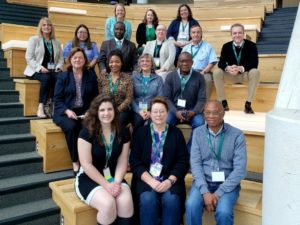FACULTY:
Elizabeth Blake
Director of Business Development
Inera Inc.
Belmont, Massachusetts
Stacy Christiansen
Managing Editor
JAMA
Chicago, Illinois
Annette Flanagin
Executive Managing Editor
JAMA and the JAMA Network
Chicago, Illinois
Tom Lang
Principal
Tom Lang Communications and Training International
Kirkland, Washington
Peter J Olson
Senior Copyediting Coordinator
Sheridan Journal Services
Waterbury, Vermont
REPORTER:
Marjorie Jean-Baptiste
National Registry of Emergency Medical Technicians
Columbus, Ohio
Let’s be clear; there was nothing short about the Short course for Manuscript Editors. The five-session, seven-hour course was taught by five faculty members who collectively have decades of industry-related experience. Even still, Peter Olson, the Course Coordinator, stated, “we learn from you,” as he encouraged a group of approximately fifteen attendees to share our experiences and to ask questions throughout the course. The objective of this report is to provide a brief, personal account of the course and, essentially, what I learned from them.
Elizabeth Blake’s session, “Microsoft Word Tips for Manuscript Editors,” offered numerous ways anyone who writes or edits can use Microsoft Word more effectively. From document formatting and keyboard shortcuts to how to incorporate custom dictionaries and customize the Word ribbon, the material was all-encompassing. Sure, while many of the tips and tricks of Microsoft Word can be found “buried in the bottom drawer of a file cabinet,” as Blake said, once you find them, you’ll wonder how you ever accomplished anything without them.
Never taken a statistics course? Have no worry. Basic mathematical mistakes, incomplete or missing data, and incorrectly reported data, can all be caught with enough diligence and some simple strategies. “One of the ways to keep track of things is to create a flow chart of the sample selection process,” Tom Lang suggested during his session on “Statistical Errors Even YOU Can Find.” Such a chart allows you to account for all patients in a study, indicates the research design, and provides the group sizes that provide denominators for calculations such as percentages and ratios. He concluded his session by explaining that the effective communication of research results depends on the accuracy of the results and how the information is framed. He also cautioned against confusing the results with the conclusion; instead, the results should be detailed in the results section, and the implications of the results should be discussed within the body of the conclusion.
Based on several different studies, a high rate of errors is found among citations and reference lists, as noted in the session “Editing References.” Fortunately, there is software that can help with reference and citation management and, subsequently, can help to decrease the number of errors in a manuscript. As Stacy Christiansen noted, “manuscript editors are the gatekeepers of quality, accuracy, and consistency,” and that includes ensuring that references are functional and, thus, discoverable for readers.
Manuscript editors are the gatekeepers of quality, accuracy, and consistency.
Peter Olson’s session, “(Some) Best Practices of STM (Scientific, Technical, and Medical) Editing,” was another session any copyeditor or manuscript editor could benefit from. A part of this session involved the attendees splitting up into roundtable discussion groups to bolster engagement during the class exercises. These consisted of extrapolations of previously written scientific articles to facilitate understanding of topics covering abbreviations, ambiguity, consistency, redundancy, and word usage. Olson stated, “You would never want to pluralize units of measure,” during the discussion about abbreviations. Likewise, caution should be taken when writing and abbreviating certain nouns. For instance, computed tomography scans should be abbreviated as CT scans not CTs, and ultraviolet rays should be abbreviated as UV rays not UVs. Seemingly minor mistakes such as these and others could pose serious implications if overlooked.
Annette Flanagin’s session entitled “Ethical and Legal Issues in Scientific Editing” covered topics on authorship and authorship issues, conflicts of interest, copyright, publication licensing, permissions to publish identifiable information, protecting participants’ rights in research, and how to handle corrections after a manuscript has been submitted. “As the number of authors are increasing so are authorship disputes,” Flanagin stated, and “if there are author problems, then there may also be problems with the integrity of the work.” A packet of materials was provided to attendees to support the session, and roundtable discussion groups were convened to offer additional guidance on how to address common ethical and legal issues with group authorship, authorship concerns, and conflicts of interest.
Whether you’re a manuscript editor or copyeditor, or someone who simply enjoys writing or editing and learning from others, the CSE Short Course for Manuscript Editors is an interactive course packed with the right amount of useful information.

